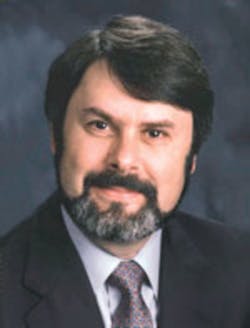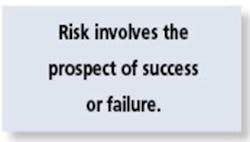Globalization is not a negative word if you learn how to play the game.
Like many companies born in the 1950s, B+K Precision was challenged by the rapid globalization that transformed our industry in the last 25 years. As with other industries, B+K watched its domestic growth as competitors and customers moved operations to Asia. One of the most troubling aspects of this process was seeing Asian competitors enter B+K�s home market with substantially lower prices.
It�s the Customer
The first task for any new manager is to take stock of the situation. Like a poker player, a manager needs to look at the cards dealt before making strategic decisions. The manager examines the situation, evaluates the competitive players, and assesses the markets served. It is vital to understand available assets such as finances, employees, patents, brand recognition, channel of distribution, and existing products and liabilities including obsolete equipment, technologies, and debt.
When this has been accomplished, you are in a position to evaluate the risks for your bets. In other words, a successful company of any size must identify its strengths and weaknesses, then decide how to position itself in the market. But nothing is more important than understanding who are your customers and what are their needs.
B+K Precision had enviable brand recognition but old designs. When I acquired the company, its cost structure was high, and there were few new products in the pipeline. Over the years, B+K Precision had lost touch with its customers. The company knew how to market and support customers after the sale but could not keep up with efficient manufacturing and design new products fast enough for the rapidly changing market.
Have a Roadmap
Once management has a clear understanding of the situation, the next step is to create the vision of where the company will be in five, 10, or 25 years and chart the roadmap that will take it there. It�s like a jigsaw puzzle but with ever-changing pieces. You must start with a clear picture; otherwise, it is nearly impossible to put the pieces together.
Here is the picture we formed for B+K Precision: A global company that operates from multiple partner locations, each doing what they do best. Very few companies in the world, regardless of their markets, are good at everything. Companies that are number one in their markets usually excel in only one area.
We looked for partners that were strong where we were weak, such as manufacturing and R&D. We found our partners in Taiwan, Romania, India, China, Slovakia, and France.
From our roadmap, we had good understanding of the actions necessary to create competitive products, and as a result, our global teams worked well together. We conveyed our needs and expectations, and our global partners told us what they could do.
Our design partners understood the needs we conveyed to them, and they produced quality products that were efficient to manufacture. In time, these partners, through outright acquisition or joint venture, joined our group of companies. Once you develop a good relationship and get to know the other company, it is easier to combine the teams.
Communications
In any organization, communications are critical. It is essential to have direct and open communications between management and employees, between a company and its customers, between a company and its suppliers, and between the company and its shareholders. To communicate effectively, managers and employees must all agree to actively listen, ask questions, and learn before taking action.
As an international company, we soon discovered that communications and managing went together. Our challenges multiplied with our expansion. We operated in diverse cultures and worked across different time zones.
Language barriers were one of the first obstacles that we addressed. Although English is the international language of business, not everyone shares an equal comprehension nor understands the slang we use in the United States.
We made sure we phrased and rephrased sentences to verify that our people and partners understood clearly what was meant. I speak several languages. This is a great asset that helps me facilitate this understanding and bridges the communications gap.
In addition to the actual spoken words, be aware of how communications are shared. When communicating to a non-English speaking person, I often remind people not to raise their voices but speak slower and in shorter sentences. I learned this from experience while studying English. People aren�t deaf; it�s just hard to follow people when they speak fast.
The Internet is a great communications tool and an inherent part of the globalization process. It helps us communicate with our customers, distributors, and partners around the world. We can share data rapidly at minimal cost. Using the Internet allows us to introduce a product faster and offer 24-hour customer support by posting all necessary information on our website.
Coaching
As a manager, I think it is more important to develop a spirit of cooperation in the team than to develop individual stars. My goal is to be a coach so people can become good team players. I find an analogy in the game of soccer. Many times a mediocre team can beat an all-star if a coach can bring the players together.
Part of this team building is to guide people to excel at what they like best. The effective coach who builds a solid team knows his players and the skills that each brings to the team.
My philosophy in life is simple: Life is too short to spend it working at something you don�t enjoy. My greatest business commandment is doing what you love best. If people really enjoy their work, they are more productive, creative, and happier and make the entire organization a more pleasant environment.
As a leader and manager, you have a great responsibility for your people. You must care for all your employees. They are the greatest assets your company has. We read this in every management text, but it is especially true within the global economy. Always treat people fairly. People watch what you are doing more than what you say.
Allow Risks
Risk involves the prospect of success or failure. Success is the easy part. Winners have their reward. Failure is another matter. We hear people say that it�s OK to make mistakes. Reality often takes another turn. I have found it is important to give permission for people to make mistakes. I encourage people to think out of the box.
An engineer was once asked how he could extend life. He said, �Well, if you cannot make it longer, why not make it wider.� People have different risk tolerance levels. Calculated risks have a better chance of success than blindly diving into the unknown.
The more data is collected before a decision is made, the better the chances for a desirable outcome. Every opportunity carries risk. The challenge is to minimize the risk through data collection and analysis and, in the end, take the risk. It is far better to take a risk than to do nothing.
Be Organized
Every year, I resolve to be better organized than the year before. Today we have so many great tools to keep us better organized: computers, PDAs, mobile communicators. Every week brings a new gadget or enhancement. The trick is to know how and where to find the information you need.
Computers are great for processing and keeping track of data. But remember, garbage in equals garbage out. Make sure you input the proper information. Develop a filing system. This is as important as having good computers.
Organization assumes the ability to prioritize. The most important tasks and projects come first. Help your people to organize and prioritize.
Don�t Waste Time and Resources
Time management is critical for every employee to understand and practice. Being a nonrenewable resource, time wasted results in high costs.
Management sets the pattern. Don�t hold meetings without a clear agenda and a time limit. Eliminate errors, redundancy, and waste. Stay current with your field and new technologies that can help in your business.
Recognize that a business is a dynamic organism that every now and again needs to reinvent itself. Don�t waste time in an attempt to keep the old or protect the obsolete.
Focus the Company
Once the management team decides the direction of the company�specifically in which market they want the company to participate�it takes a team effort to bring all the employees onboard. Every goal and objective must be well defined and clearly explained at every level. Everyone in the company must understand their individual role in fulfilling these goals.
When B+K decided it was to be the company that offers exceptional value in test equipment, we had to reposition ourselves in many market segments we were serving. We decided we cannot be everything for everybody.
In short, our focus became to offer solid products of uncompromised quality and reliability at reasonable prices. To accomplish this, we cut out the bells and whistles that only a few customers needed or wanted and focused on offering accuracy and ease of use.
At the same time, we improved our customer listening skills by establishing a better feedback system using the Internet. This allowed us to develop products targeted toward specific applications. These included high current power supplies for industrial applications, HDTV pattern generators for the installers, and our arbitrary function generator that can be used in a variety of applications from electronic to medical to vibration analysis.
Globalization Is Here
We are a company that does what most companies do: R&D, manufacture, market, and service. Unlike other companies our size, our pieces of the puzzle are spread around the globe in one united B+K family.
Globalization enables businesses to operate more efficiently and, at the same time, provides the resources to raise the standard of living for employees everywhere. By doing this, we are developing new markets for our products. We are breaking the barriers between countries and people. As the world becomes smaller, it should become a better place for everybody.
About the Author
Victor E. Tolan is CEO and president of B+K Precision. He started as an engineer for General Motors in France, entered the test and measurement business in 1979 as an R&D engineer for Beckman Instruments, and later served as director of sales and marketing for ITT Pomona Electronics. Mr. Tolan holds an engineering degree and an M.B.A. from California State University. B+K Precision, 22820 Savi Ranch Parkway, Yorba Linda, CA 92887, 714-921-9095, e-mail: [email protected]
May 2006


